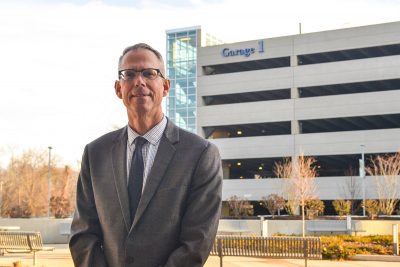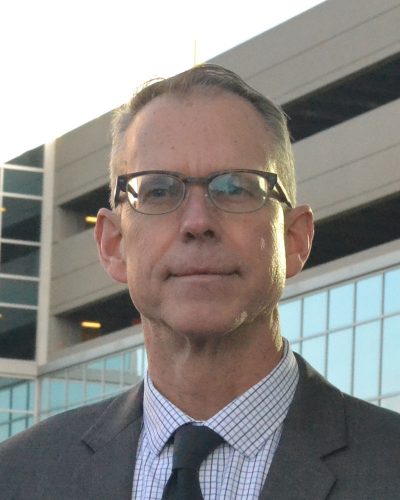
Parking has been known to be a polarizing issue on our campus. But most would agree that as the Bioscience Connecticut construction led to the addition of three garages, we’re at a much better place today. The man who oversees parking (and transportation, and event services) is Allan Peterson. Allan’s been at UConn Health for three years now. He lives in Griswold with his wife and the two youngest of their four children.
How has parking and transportation on our campus improved over the last few years?
In terms of parking the key improvement has been increased capacity (spaces) in high-demand areas. This has allowed us to offer additional Area 1 permits which in turn led to more convenient Area 3 spaces becoming available. We were also able to provide evening and weekend enhancements for our students and residents. And although smaller in scale, the repaving and restriping of several surface lots simply makes it easier to get in and out of spaces. We’ve also had some nice improvements in transportation services on campus with our new shuttles, well trained drivers, and the handy mobile app and desktop link which let you know where your shuttle is. CTtransit and CTfastrak have also been great partners by improving access to our campus from throughout the region. They are now carrying more than 4,000 passengers per month to and from our campus.
To what do you attribute that success?
To me it’s really a great story about teamwork. It all started with buying into our leadership’s vision of what Bioscience Connecticut and UConn Health would become. Then the people responsible for planning, safety, and operations worked together to understand the traffic and parking demands so we could create the best possible experience for the whole community. Of course there will always be bumps along the way when you undertake this type of amazing growth, but with everyone’s hard work, patience and perseverance we’re beginning to see some very good outcomes.

Allan Peterson
Favorite
sports team:
Go Huskies!
Favorite delicacy:
My wife’s grilled fish on top of spinach and mashed potatoes.
Favorite way to unwind:
Waterskiing
Favorite vacation:
A few days exploring a national park with family and friends.
Something about you today that your younger self would never believe:
I drive a Prius.
People may not realize, your work is about more than lots and garages. What else does your office handle?
Although parking is a big piece, it’s not everything. Here’s a snapshot of what we handle.
- 6,500 parking permits for staff, students, residents and contractors
- Parking for more than 2,000 patients and visitors daily
- 5,100 campus wide parking spaces
- Valet parking at the University Tower, Main Building & Outpatient Pavilion
- Campus shuttles which transport over 40,000 passengers annually
- Partnering with CTrides and CTtransit to promote regional transportation services
- Maintenance of the garages and parking equipment
- Room scheduling for more than 4,000 meetings and events annually
- Coordination of special event services
What would you say is the most misunderstood thing about parking?
One of the most common questions we hear in the parking world is, ‘Why do we charge for parking’? You will hear this from time to time at many institutions and municipalities across the country, especially during times of major growth. There is a great book (for transportation geeks like me), The High Cost of Free Parking, written by Donald Shoup, Ph.D., professor of urban planning and economics at UCLA. The book examines parking’s impact on society, the economy and the environment, and how a shift in the approach to transportation planning, engineering and operations can lead to many long-term benefits. The gist of the book is that for many decades the real costs of parking—maintaining driveways, sidewalks, lots, garages, and signage—were hidden by free or subsidized parking spaces, which in many cases lead to additional costs driven by declining infrastructures, traffic congestion, pollution, lost time, etc. One of Shoup’s recommendations, which has been widely adopted, was to first understand the planned utilization and demand of parking areas, and then to set pricing based on the distance from the destination, traffic demands, and fair market rates. Among the benefits would be reduced traffic congestion and pollution (by cutting down on ‘cruising for parking’), time savings, and modest revenues that can be reinvested into the community for maintenance, repairs, and other sustainable transportation programs.
What’s left to do in terms of parking on our campus?
Over the coming year we will be installing a new wayfinding sign package and bringing two visitor parking lots back on line. We’ll also continue to assess traffic demand and where it makes sense to initiate programs that improve efficiency and sustainability. Nevertheless, the real key to our long-term success is our staff’s caring, attentive approach, and diligence in making sure that we are providing a clean, welcoming, and safe environment so that everyone’s arrival and departure is as seamless as possible. We have this saying that goes, “Every day we have an opportunity to create an exceptional first and last impression for everyone at UConn Health.” That’s what we’re striving for: everyone, every day!